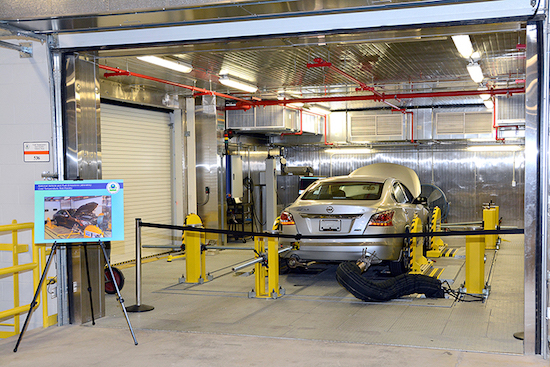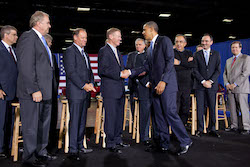Trump Review of Auto Emissions Standards Upsets Deal [1]
 |
| A cold temperature test facility at EPA's National Vehicle and Fuel Emissions Laboratory in Ann Arbor, Mich., during a showcase on Oct. 9, 2014. Photo: U.S. EPA [3], Flickr Creative Commons |
Backgrounder: Trump Review of Auto Emissions Standards Upsets Deal
By Joseph A. Davis
President Donald Trump’s announcement [4] March 15 that he would undo the auto mileage standards set under former President Barack Obama may appear at first blush to be a done deal. But in actuality, the issue is far from settled.
This is a story that will keep on giving news to environmental journalists. An understanding of the backstory may rescue reporters from accepting too simple a narrative [5] handed out in “media events [6].”
First, auto mileage matters for many reasons. Fuel efficiency improvements help reduce smog, slow climate change, reduce national petroleum dependence and save drivers money. They even help sell new cars.
But when gas prices are low, as they are now, many consumers prefer the gas-guzzling muscle machines, the SUVs and the pickup trucks. Automakers make money from those, too.
Any real change would take a long time.
It could not be done by presidential fiat.
Second, Trump did not roll back mileage standards March 15. What he did was announce that his agencies would reconsider the “mid-term review” of whether to keep tightening standards that are already tight and largely locked in.
Any real change would take a long time. It could not be done by presidential fiat — the dramatic signing of a piece of paper in front of TV cameras. It would take a long slog of regulatory proceedings, followed by a long grind of lawsuits — which might not be resolved until after Trump leaves office.
Some news media played the story as a “big win [7]” for the auto industry. In fact, the main U.S. automakers had pushed for such a gesture from Trump and are happy. Environmentalists, conversely, are unhappy [8] and promise to see the Trump administration in court. But the points are not on the scoreboard.
A big story with many angles
For environmental reporters, there are a lot of ways into this story. Regulatory proceedings, court cases, jobs, technology, driving habits, consumer choice, tailpipe emissions, gas prices, recreation, city traffic — and let’s not leave out diesel cheating. Behind them all is climate.
It’s also worth noting that there are at least two agencies involved in the decision: the U.S. Environmental Protection Agency, which sets auto emission standards under the Clean Air Act [9], and the Transportation Department’s National Highway Traffic Safety Administration, which sets auto mileage standards [10] under the Energy Policy and Conservation Act of 1975.
 |
| Former President Barack Obama greets auto industry executives at a Washington, D.C., event on July 29, 2011. Photo: Official White House photo [11], Pete Souza |
Fuel efficiency (mileage) and tailpipe emissions of pollutants are closely related — which is why a two-agency tandem approach to regulation has evolved in recent years.
A lot of things come out of a tailpipe. Decades ago, the regulatory emphasis was on pollutants that cause smog, lung damage and other health problems — nitrogen oxides, particulates, lead, sulfur, hydrocarbons (unburnt fuel) and carbon monoxide.
More recently, additional focus has fallen on carbon dioxide, which causes climate change. Better mileage translates pretty directly into lower carbon dioxide emissions per mile driven. EPA estimates car and truck emissions account for roughly one-fifth [12] of total U.S. carbon dioxide emissions.
Our story to date — the Obama standards
It was literally a big deal [13] when Obama, in July 2011, announced an agreement [14] on emissions and mileage standards for cars and light trucks through 2025, flanked by representatives [15] of all the major automakers, the United Auto Workers and the state of California.
The agreement had been a product of intense negotiations [16], with plenty of politics and significant compromise. No whimper of unhappiness from the auto industry was heard. Many in the industry could still remember that Obama had engineered [17] the rescue [18] of the auto industry from near-collapse in 2009. In May of 2011, the average price of gasoline in the U.S. was near $4 a gallon [19].
The media narrative [20] was that carmakers were on the path to a fuel-efficient future and that carmakers were confident they could get there and keep making money.
The 2011 vehicle emissions deal was actually one of the most important components of Obama’s overall program for addressing climate change.
The 2011 mileage/emissions deal was itself a compromise. The agreement required U.S. vehicle fleets to average 54.5 miles per gallon or 163 grams per mile of carbon dioxide by 2025. Environmentalists and California had been pushing for something more ambitious — closer to 62 mpg.
In 2010, fleets were only averaging 28.3 mpg, and the deal set a timetable for mileage to step up annually on the way to 2025. Today, the fleet standard is 35.5 mpg. But the deal also provided for a “midterm review [21]” in spring 2018 to assess the feasibility of reaching the 2025 goal.
Then the price of gasoline plummeted and Trump was elected president. Lower gas prices increased consumer demand for less-efficient vehicles. The “mid-term review” offered an opportunity to sidetrack the ratcheting-up of mileage standards.
The Obama standards are actually locked in [22] until 2021. But the mid-term review could weaken the further improvements slated for the years 2022-2025. Before leaving office in January 2017, the Obama EPA declared [21] that the mid-term review was not needed because automakers had already shown the 2025 standards to be achievable [23]. In effect, EPA had done the mid-term review early in an effort to lock in [24] the 2025 standards.
Trump falsely declares Obama “assault” on auto industry
Trump’s election was based partly on promises of deregulation [25], if not actually getting rid of [26] EPA altogether. Even before [27] Trump was inaugurated, his EPA pick Scott Pruitt declared [28] he would review the auto emissions rule.
With a signal that clear, the auto industry had only to ask for what it wanted. And it did. Two industry groups wrote the EPA administrator [29] in February 2017 asking him to reverse the Obama EPA’s January decision. The two were the Alliance of Automobile Manufacturers [30] (aka the Auto Alliance) and the Association of Global Automakers [31].
Just to make sure the message was sent, the Auto Alliance sued to reverse [32] EPA’s January action.
Even though EPA had already finalized the decision to review the mid-term review two days beforehand [33], Trump went to Detroit for a media event on March 15 and “ordered [7]” it to be done, to quote the Reuters account. Reuters described the Detroit event as a “Big Win” for the industry in its headline.
Trump took the occasion to assail the Obama administration (previously hailed in Detroit as savior of the industry) for what he called its “assault” [34] on the auto industry.
It was a media event. Trump was flanked by reps of major automakers and the United Automobile Workers labor union. As the cameras rolled, Trump tried to make it a story about jobs, but even carmakers didn’t give him credit [35] for that.
Another way to see the event was an early step in his 2020 reelection campaign to win a state that many had predicted would not swing his way in 2016 (Trump ultimately won Michigan by only 13,225 votes [36]).
An extra wrinkle in this story is California [37] — which has long had some of the nation’s worst smog and has pioneered the nation’s most aggressive air pollution programs to deal with it … and which did not vote for Trump.
California has waivers from EPA allowing it to enforce its own stricter vehicle emission standards, and also to implement a pace-setting “zero emission vehicle” program. That means electric cars.
The Trump administration has been hinting [38] that it might go after California’s waivers. Some think loss of those waivers could jeopardize [22] the whole electric car industry. Others think not. [35]
Story angles, sources
Especially if you live in an urban area, you might want to check in with your state or regional metropolitan air quality agency to see how the standards might affect pollution in your area.
Another angle is to look for major manufacturing plants near you, to see whether they are making SUVs, light trucks or electric cars.
Some sources on the industry side include the Auto Alliance [39], the Association of Global Automakers [40] and the United Auto Workers [41].
Some sources on the environmental side include the Natural Resources Defense Council [42], the Union of Concerned Scientists [43] and the Safe Climate Campaign [44].
Other useful sources may include the Manufacturers of Emission Controls Association [45], the National Association of Clean Air Agencies [46], the California Air Resources Board [47] and the American Trucking Associations [48].
Joseph A. Davis [49] is director of SEJ’s WatchDog Project, and writes SEJournal Online’s Backgrounders and TipSheet columns.
* From the weekly news magazine SEJournal Online, Vol. 2, No. 13. Content from each new issue of SEJournal Online is available to the public via the SEJournal Online main page [50]. Subscribe to the e-newsletter here [51]. And see past issues of the SEJournal archived here. [50]

